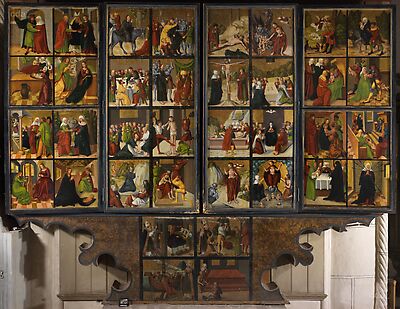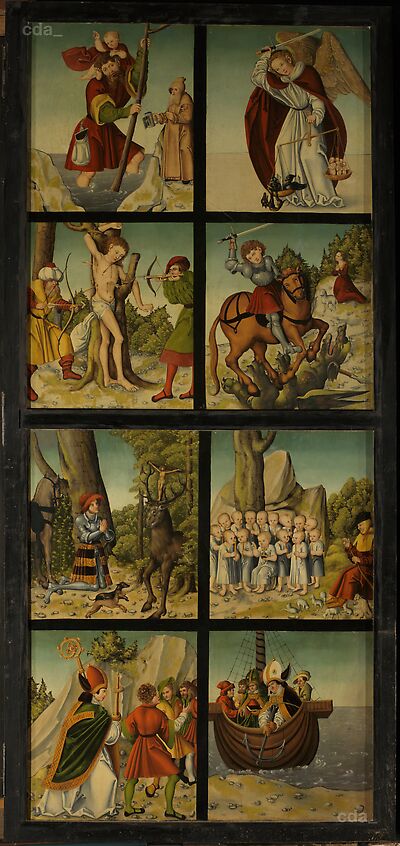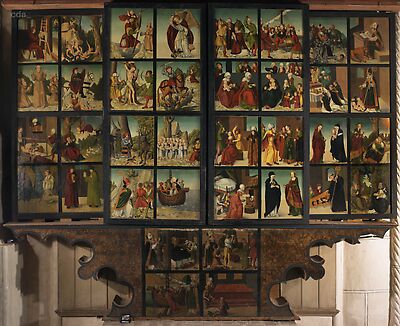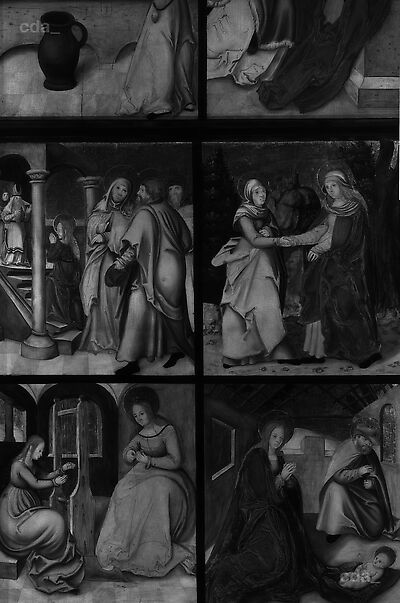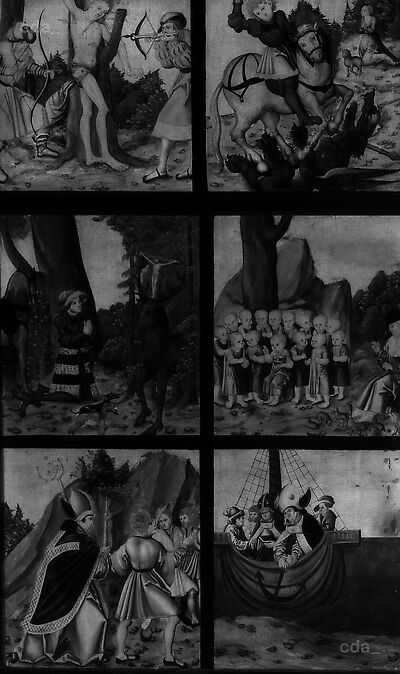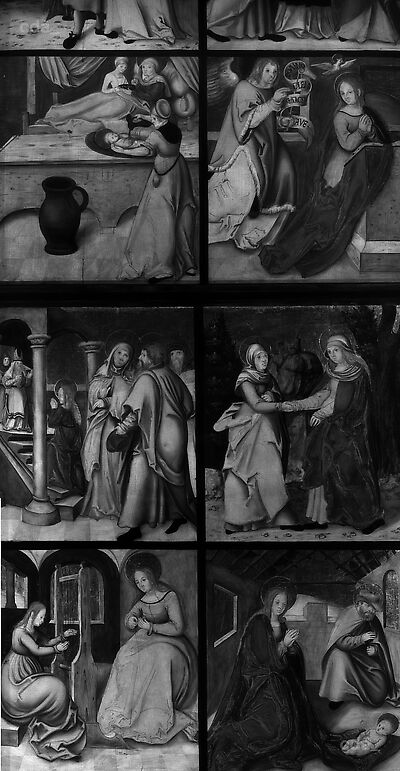Meeting at the Golden Gate (an infrared reflectogram is not available)
The Birth of the Virgin
DESCRIPTION
Tools/Material:
- fluid, black medium, brush
Type/Ductus:
- relatively detailed and freehand underdrawing after a pre-existing design
- thin lines
- occasional hatching strokes
Function:
- relatively binding for the final painted version; the lines define the main contours and describe essential details and facial features; volume is represented with occasional hatching strokes
Deviations:
- minor corrections were made to forms during the painting process; small changes (e. g. the lock on the chest was not executed in the painted version)
INTERPRETATION
Attribution:
- not possible (not Cranach workshop)
The Virgin is brought to the Temple
DESCRIPTION
Tools/Material:
- fluid, black medium, brush
Type/Ductus:
- relatively detailed and freehand underdrawing after a pre-existing design
- thin lines
- occasional hatching strokes
Function:
- relatively binding for the final painted version; the lines define the main contours and describe essential details and facial features; volume is represented with occasional hatching strokes
Deviations:
- minor corrections were made to forms during the painting process; small changes (e. g. the size of the Virgin’s head)
INTERPRETATION
Attribution:
- not possible (not Cranach workshop)
Life in the Temple School
DESCRIPTION
Tools/Material:
- black medium, brush
Type/Ductus:
- relatively detailed and freehand underdrawing after a pre-existing design
- thin lines (occasional beading)
Function:
- relatively binding for the final painted version; the lines define the main contours and describe essential details and facial features; no representation of volume with hatching strokes
Deviations:
- minor corrections were made to forms during the painting process; small changes
INTERPRETATION
Attribution:
- not possible (not Cranach workshop)
The Marriage (an infrared reflectogram is not available)
The Annunciation
DESCRIPTION
Tools/Material:
- fluid medium, brush; an initial design may have been executed in a diluted medium
Type/Ductus:
- freehand underdrawing after a pre-existing design
- thin lines (occasional beading)
- hatching strokes
Function:
- binding to relatively binding for the final painted version; the lines define the main contours and describe essential details and facial features; representation of volume with hatching strokes
Deviations:
- minor corrections were made to forms during the painting process, small changes (e. g. the angel’s head)
INTERPRETATION
Attribution:
- not possible (not Cranach workshop)
The Visitation
DESCRIPTION
Tools/Material:
- fluid medium, brush
Type/Ductus:
- freehand underdrawing after a pre-existing design
- thin lines
Function:
- binding to relatively binding for the final painted version; the lines define the main contours and describe essential details and facial features, no representation of volume with hatching strokes
Deviations:
- minor corrections were made to forms during the painting process; small changes (e. g. position of the feet and the faces)
INTERPRETATION
Attribution:
- not possible (not Cranach workshop)
The Nativity
DESCRIPTION
Tools/Material:
- fluid medium, brush
Type/Ductus:
- freehand underdrawing after a pre-existing design
- thin lines
Function:
- binding to relatively binding for the final painted version; the lines define the main contours and describe essential details and facial features; no representation of volume with hatching strokes
Deviations:
- minor corrections were made to forms during the painting process; small changes (e. g. the infant Christ’s arm, the faces)
INTERPRETATION
Attribution:
- not possible (not Cranach workshop)
Verso:
Saint Christopher (an infrared reflectogram is not available)
The Martyrdom of St Sebastian
DESCRIPTION
Tools/Material:
- fluid medium, brush
Type/Ductus:
- freehand underdrawing after a pre-existing design
- thin lines
Function:
- binding to relatively binding for the final painted version; the lines define the main contours and describe essential details and facial features; no representation of volume with hatching strokes
Deviations:
- minor correction were made to forms during the painting process; small changes (e. g. in the background between the archers at the left; th ebow of the archer on the right)
INTERPRETATION
Attribution:
- not possible (not Cranach workshop)
St Eustache
DESCRIPTION
Tools/Material:
- fluid medium, brush(?)
Type/Ductus:
- freehand underdrawing (where visible)
- thin lines
Function:
- binding to relatively binding fort he final painted version; the lines define the main contours; no representation of volume with hatching strokes
Deviations:
- minor corrections were made to forms during the painting process (here the lines are visible)
INTERPRETATION
Attribution:
- not possible (not Cranach workshop)
St Blaise
DESCRIPTION
Tools/Material:
- fluid medium, brush (?)
Type/Ductus:
- freehand underdrawing (where visible)
- thin lines
Function:
- binding fort he final painted version; the lines define the main contours; no representation of volume with hatching strokes
Deviations:
- minor corrections were made to forms during the painting process (lines are only visible here)
INTERPRETATION
Attribution:
- not possible (not Cranach workshop)
The Archangel Michael with the Souls in a Weighing Scales (an infrared reflectogram is not available)
St George and the Dragon
Tools/Material:
- fluid medium, brush; an initial design (?) in a dry drawing material, stylus, is occasionally visible
Type/Ductus:
- freehand underdrawing after a pre-existing design
- thin lines
Function:
- only relatively binding for the final painted version; the lines define the main contours and describe essential details and facial features; no representation of volume with hatching strokes
Deviations:
- minor corrections were made to forms during the final painted version; numerous small changes (e. g. the horse’s legs and harness, the dragon‘s head)
INTERPRETATION
Attribution:
- not possible (not Cranach workshop)
The Fourteen Helpers in Need
DESCRIPTION
Tools/Material:
- fluid medium, brush (?)
Typ/Duktus:
- freehand underdrawing (where visible)
- thin lines
Function:
- binding for the final painted version; the lines define the main contours; no representation of volume with hatching strokes
Deviations:
- minor corrections were made to forms during the painting process (only here are lines visible)
INTERPRETATION
Attribution:
- not possible (not Cranach workshop)
St Nicholas
DESCRIPTION
Tools/Material:
- fluid medium, brush(?)
Type/Ductus:
- freehand underdrawing (where visible)
- thin lines
Function:
- binding for the final painted version; the lines define the main contours; no representation of volume with hatching strokes
Deviations:
- minor corrections were made to forms during the painting process (only here are lines visble)
INTERPRETATION
Attribution:
- not possible (not Cranach workshop)
[Sandner, Heydenreich, Smith-Contini, cda 2017]
![The Bernau Altarpiece [left alteration wing]: Live of the Virgin [recto], Live of Saints [verso]](https://lucascranach.org/imageserver-2022/DE_StMB_NONE-001c_FR-none/01_Overall/DE_StMB_NONE-001c_FR-none_2016-02_Overall-s.jpg)
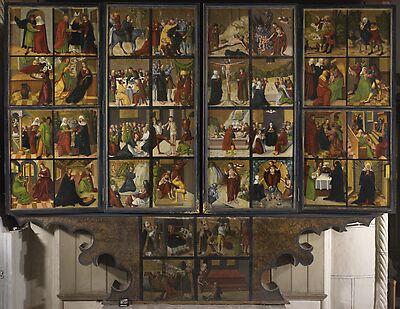
![The Bernau Altarpiece [right alteration wing]: The childhood of Christ [recto], Live of Saints [verso]](https://lucascranach.org/imageserver-2022/DE_StMB_NONE-001d_FR-none/01_Overall/DE_StMB_NONE-001d_FR-none_2016-02_Overall-s.jpg)
![The Bernau Altarpiece [left side wing]: The Golden Legend (Aurea Legenda)](https://lucascranach.org/imageserver-2022/DE_StMB_NONE-001e_FR-none/01_Overall/DE_StMB_NONE-001e_FR-none_2016-02_Overall-s.jpg)
![The Bernau Altarpiece [right side wing]: The Golden Legend (Aurea Legenda)](https://lucascranach.org/imageserver-2022/DE_StMB_NONE-001f_FR-none/01_Overall/DE_StMB_NONE-001f_FR-none_2016-02_Overall-s.jpg)
![The Bernau Altarpiece [predella]: St Nicholas legend](https://lucascranach.org/imageserver-2022/DE_StMB_NONE-001g_FR-none/01_Overall/DE_StMB_NONE-001g_FR-none_2016-02_Overall-s.jpg)
![The Bernau Altarpiece [left inner wing]: Passion of Christ [verso]](https://lucascranach.org/imageserver-2022/DE_StMB_NONE-001a_FR-none/01_Overall/DE_StMB_NONE-001a_FR-none_2016-02_Overall-s.jpg)
![The Bernau Altarpiece [right inner wing]: Passion of Christ [verso]](https://lucascranach.org/imageserver-2022/DE_StMB_NONE-001b_FR-none/01_Overall/DE_StMB_NONE-001b_FR-none_2016-02_Overall-s.jpg)
